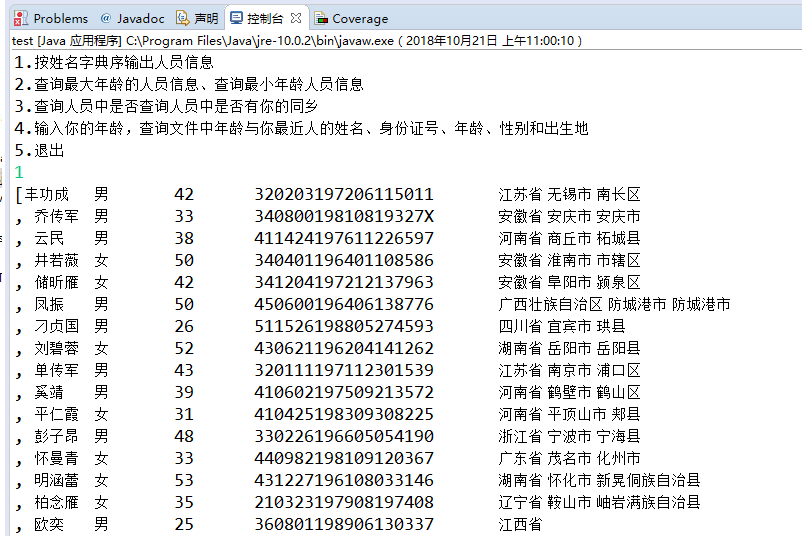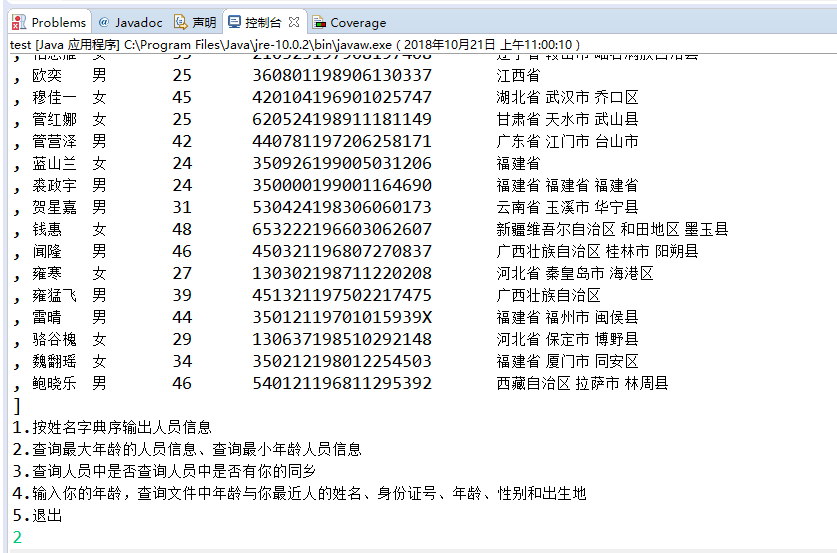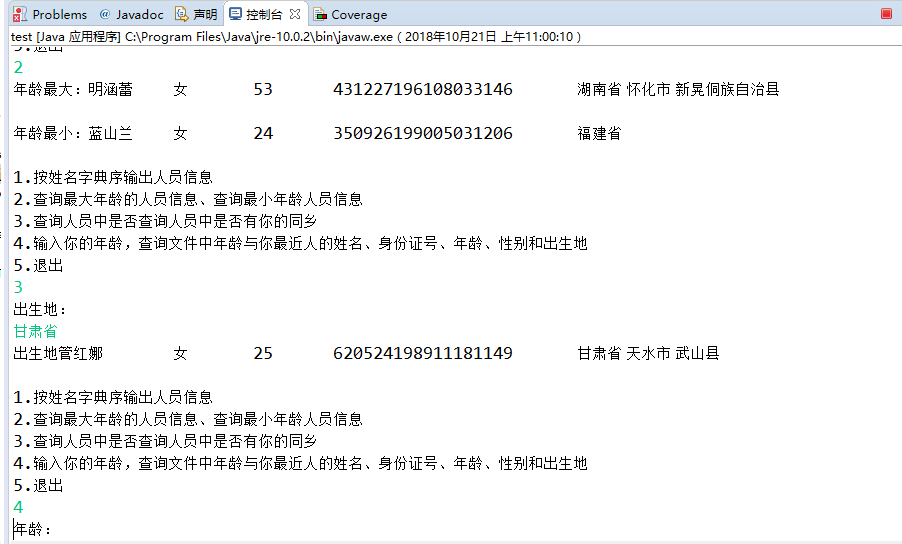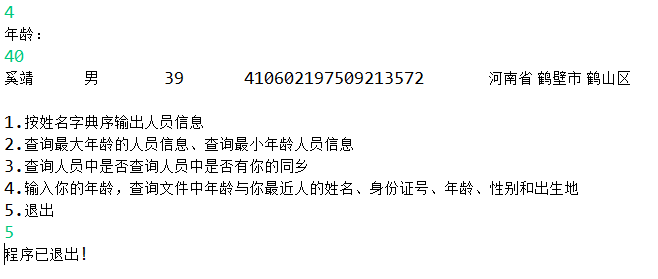一.理论知识部分
1.Java为了克服单继承的缺点,Java使用了接口,一个类可以实现一个或多个接口。
2.在Java程序设计语言中,接口不是类,而是对类的一组需求描述,由常量和一组抽象方法组成。接口中不包括变量和具体实现的方法。
3.只要类实现了接口,则该类要遵从接口描述的统一格式进行定义,并且可以在任何需要该接口的地方使用这个类的对象。
4.接口声明方式: public interface 接口名。接口体中包含常量定义和方法定义,接口中只进行方法的声明,不提供方法的实现。类似建立类的继承关系,接口也可以扩展。
5.接口的扩展方法:public interface 接口1 extends 接口2
6.(1)通常接口的名字以able或ible结尾;(2)可以使用extends来继承接口的常量和抽象方法,扩展形成新的接口;(3)接口中的所有常量必须是public static final,方法必须是public abstract,这是系统默认的,不管你在定义接口时,写不写修饰符都是一样的。
7.接口的实现:在类声明时用implements关键字声明使用一个或多个接口。一个类使用了某个接口,那么这个类必须实现该接口的所有方法,即为这些方法提供方法体。一个类可以实现多个接口,接口间应该用逗号分隔开。
8.接口不能构造接口对象,但可以声明接口变量以指向一个实现了该接口的类对象。可以用instanceof检查对象是否实现了某个接口。
9.接口:用interface声明,是抽象方法和常量值定义的集合。从本质上讲,接口是一种特殊的抽象类,这种抽象类中只包含常量和方法的定义,而没有变量和方法的定义。接口中只能定义抽象方法,而且这些方法默认为是public的。只要类实现了接口,就可以在任何需要该接口的地方使用这个类的对象。一个类可以实现多个接口。
10.接口与抽象类的区别:(1)接口不能实现任何方法,而抽象类可以。(2)类可以实现许多接口,但只有一个父类。(3)接口不是类分级结构的一部分,无任何联系的类可以实现相同的接口。
11.回调(callback):一种程序设计模式,在这种模式中,可指出某个特定事件发生时程序应该采取的动作。
12.在java.swing包中有一个Timer类,可以使用它在到达给定的时间间隔时触发一个事件。
13.Comparator接口的用途:处理字符串按长度进行排序的操作。
14.Qbject类的克隆方法:当拷贝一个对象变量时,原始变量与拷贝变量引用同一个对象。这样,改变一个变量所引用的对象会对另一个变量产生影响。如果要创建一个对象新的copy,它的最初状态与original一样,但以后可以各自改变状态,就需要使用Object类的clone方法。
15.Object类的clone()方法是一个native方法。Object类中的clone()方法被protected修饰符修饰。这意味着在用户编写的代码中不能直接调用它。如果要直接应用clone()方法,就需覆盖clone()方法,并要把clone()方法的属性设置为public。Object.clone()方法返回一个Object对象。必须进行强制类型转换才能得到需要的类型。
16.java中对象克隆的实现:在子类中实现Cloneable接口。为了获取对象的一份拷贝,可以利用Object类的clone方法。在子类中覆盖超类的clone方法,声明为public。在子类的clone方法中,调用super.clone()。
17.Java Lambda表达式是Java8引入的一个新的功能,主要用途是提供一个函数化的语法来简化编码。Lambda表达式本质上是一个匿名方法。
18.Lambda表达式的语法基本结构:(arguments)->body
19.有时候需要自定义一个函数式接口,做法也很简单,首先此接口只能有一个函数操作,然后在接口类型上标注注解@FunctionalInterface即可。
二.实验部分
1、实验目的与要求
(1) 掌握接口定义方法;
(2) 掌握实现接口类的定义要求;
(3) 掌握实现了接口类的使用要求;
(4) 掌握程序回调设计模式;
(5) 掌握Comparator接口用法;
(6) 掌握对象浅层拷贝与深层拷贝方法;
(7) 掌握Lambda表达式语法;
(8) 了解内部类的用途及语法要求。
2、实验内容和步骤
实验1: 导入第6章示例程序,测试程序并进行代码注释。
测试程序1:
l 编辑、编译、调试运行阅读教材214页-215页程序6-1、6-2,理解程序并分析程序运行结果;
l 在程序中相关代码处添加新知识的注释。
l 掌握接口的实现用法;
l 掌握内置接口Compareable的用法。
代码:
package interfaces;
import java.util.*;
/**
* This program demonstrates the use of the Comparable interface.
* @version 1.30 2004-02-27
* @author Cay Horstmann
*/
public class EmployeeSortTest
{
public static void main(String[] args)
{
Employee[] staff = new Employee[3];
staff[0] = new Employee("Harry Hacker", 35000);
staff[1] = new Employee("Carl Cracker", 75000);
staff[2] = new Employee("Tony Tester", 38000);
Arrays.sort(staff);//静态方法
// 打印员工的信息
for (Employee e : staff)
System.out.println("name=" + e.getName() + ",salary=" + e.getSalary());
}
}package interfaces;
public class Employee implements Comparable<Employee>//comparable是jdk内置接口,在lang包中,可缺省使用
{
private String name;
private double salary;
public Employee(String name, double salary)//构造方法
{
this.name = name;
this.salary = salary;
}
public String getName()//访问器
{
return name;
}
public double getSalary()
{
return salary;
}
public void raiseSalary(double byPercent)
{
double raise = salary * byPercent / 100;
salary += raise;
}
/**
* Compares employees by salary
* @param other another Employee object
* @return a negative value if this employee has a lower salary than
* otherObject, 0 if the salaries are the same, a positive value otherwise
*/
public int compareTo(Employee other)//实现接口要求包含的方法
{
return Double.compare(salary, other.salary);
}
}
若实现接口的类不是抽象类,则必须实现所有接口的所有方法,即为所有的抽象方法定义方法体。一个类在实现某接口抽象方法时,必须使用完全相同的方法名、参数列表和返回值类型。接口抽象方法的访问控制符已指定为public,所以类在实现时,必须显式地使用public修饰符。
测试程序2:
l 编辑、编译、调试以下程序,结合程序运行结果理解程序;
package interfaces;
interface A
{
double g=9.8;
void show( );
}
class C implements A
{
public void show( )
{System.out.println("g="+g);}
}
class InterfaceTest
{
public static void main(String[ ] args)
{
A a=new C( );//声明接口变量
a.show( );
System.out.println("g="+C.g);
}
}
测试程序3:
l 在elipse IDE中调试运行教材223页6-3,结合程序运行结果理解程序;
l 26行、36行代码参阅224页,详细内容涉及教材12章。
l 在程序中相关代码处添加新知识的注释。
l 掌握回调程序设计模式;
package timer;
/**
@version 1.01 2015-05-12
@author Cay Horstmann
*/
import java.awt.*;
import java.awt.event.*;
import java.util.*;
import javax.swing.*;
import javax.swing.Timer;
// to resolve conflict with java.util.Timer
public class TimerTest
{
public static void main(String[] args)
{
ActionListener listener = new TimePrinter();//无参构造器
// 构造时间监听器
// 间隔为10秒
Timer t = new Timer(10000, listener);
t.start();
JOptionPane.showMessageDialog(null, "Quit program?");
System.exit(0);
}
}
class TimePrinter implements ActionListener
{
public void actionPerformed(ActionEvent event)
{
System.out.println("At the tone, the time is " + new Date());
Toolkit.getDefaultToolkit().beep();//静态方法
}
}
测试程序4:
l 调试运行教材229页-231页程序6-4、6-5,结合程序运行结果理解程序;
l 在程序中相关代码处添加新知识的注释。
l 掌握对象克隆实现技术;
l 掌握浅拷贝和深拷贝的差别。
package clone;
/**
* This program demonstrates cloning.
* @version 1.10 2002-07-01
* @author Cay Horstmann
*/
public class CloneTest
{
public static void main(String[] args)
{
try
{
Employee original = new Employee("John Q. Public", 50000);
original.setHireDay(2000, 1, 1);
Employee copy = original.clone();
copy.raiseSalary(10);
copy.setHireDay(2002, 12, 31);
System.out.println("original=" + original);
System.out.println("copy=" + copy);
//重写克隆方法
}
//识别处理异常
catch (CloneNotSupportedException e)
{
e.printStackTrace();
}
}
}package clone;
import java.util.Date;
import java.util.GregorianCalendar;
public class Employee implements Cloneable
{
private String name;
private double salary;
private Date hireDay;
public Employee(String name, double salary)
{
this.name = name;
this.salary = salary;
hireDay = new Date();
}
public Employee clone() throws CloneNotSupportedException
{
// call Object.clone()
Employee cloned = (Employee) super.clone();
// clone mutable fields
cloned.hireDay = (Date) hireDay.clone();
//clond.name=(String)name.cloned();
//String类没有提供克隆功能
return cloned;
}
/**
* Set the hire day to a given date.
* @param year the year of the hire day
* @param month the month of the hire day
* @param day the day of the hire day
*/
public void setHireDay(int year, int month, int day)
{
Date newHireDay = new GregorianCalendar(year, month - 1, day).getTime();
// Example of instance field mutation
hireDay.setTime(newHireDay.getTime());
}
public void raiseSalary(double byPercent)
{
double raise = salary * byPercent / 100;
salary += raise;
}
public String toString()
{
return "Employee[name=" + name + ",salary=" + salary + ",hireDay=" + hireDay + "]";
}
}
实验2: 导入第6章示例程序6-6,学习Lambda表达式用法。
l 调试运行教材233页-234页程序6-6,结合程序运行结果理解程序;
l 在程序中相关代码处添加新知识的注释。
l 将27-29行代码与教材223页程序对比,将27-29行代码与此程序对比,体会Lambda表达式的优点。
package lambda;
import java.util.*;
import javax.swing.*;
import javax.swing.Timer;
/**
* This program demonstrates the use of lambda expressions.
* @version 1.0 2015-05-12
* @author Cay Horstmann
*/
public class LambdaTest
{
public static void main(String[] args)
{
String[] planets = new String[] { "Mercury", "Venus", "Earth", "Mars",
"Jupiter", "Saturn", "Uranus", "Neptune" };
System.out.println(Arrays.toString(planets));
System.out.println("Sorted in dictionary order:");
Arrays.sort(planets);
System.out.println(Arrays.toString(planets));//调用toString静态方法
System.out.println("Sorted by length:");
Arrays.sort(planets, (first, second) -> first.length() - second.length());
System.out.println(Arrays.toString(planets));
Timer t = new Timer(1000, event ->
System.out.println("The time is " + new Date()));//以毫秒为单位,1000后面的为Lambda表达式
t.start();
// keep program running until user selects "Ok"
JOptionPane.showMessageDialog(null, "Quit program?");
System.exit(0);
}
} 
实验3: 编程练习
l 编制一个程序,将身份证号.txt 中的信息读入到内存中;
l 按姓名字典序输出人员信息;
l 查询最大年龄的人员信息;
l 查询最小年龄人员信息;
l 输入你的年龄,查询身份证号.txt中年龄与你最近人的姓名、身份证号、年龄、性别和出生地;
l 查询人员中是否有你的同乡。
import java.io.BufferedReader;
import java.io.File;
import java.io.FileInputStream;
import java.io.FileNotFoundException;
import java.io.IOException;
import java.io.InputStreamReader;
import java.util.ArrayList;
import java.util.Arrays;
import java.util.Scanner;
import java.util.Collections;//对集合进行排序、查找、修改等;
public class Test {
private static ArrayList<Citizen> citizenlist;
public static void main(String[] args) {
citizenlist = new ArrayList<>();
Scanner scanner = new Scanner(System.in);
File file = new File("E:/java/身份证号.txt");
try {
FileInputStream fis = new FileInputStream(file);
BufferedReader in = new BufferedReader(new InputStreamReader(fis));
String temp = null;
while ((temp = in.readLine()) != null) {
Scanner linescanner = new Scanner(temp);
linescanner.useDelimiter(" ");
String name = linescanner.next();
String id = linescanner.next();
String sex = linescanner.next();
String age = linescanner.next();
String birthplace = linescanner.nextLine();
Citizen citizen = new Citizen();
citizen.setName(name);
citizen.setId(id);
citizen.setSex(sex);
// 将字符串转换成10进制数
int ag = Integer.parseInt(age);
citizen.setage(ag);
citizen.setBirthplace(birthplace);
citizenlist.add(citizen);
}
} catch (FileNotFoundException e) {
System.out.println("信息文件找不到");
e.printStackTrace();
} catch (IOException e) {
System.out.println("信息文件读取错误");
e.printStackTrace();
}
boolean isTrue = true;
while (isTrue) {
System.out.println("1.按姓名字典序输出人员信息");
System.out.println("2.查询最大年龄的人员信息、查询最小年龄人员信息");
System.out.println("3.查询人员中是否查询人员中是否有你的同乡");
System.out.println("4.输入你的年龄,查询文件中年龄与你最近人的姓名、身份证号、年龄、性别和出生地");
System.out.println("5.退出");
int nextInt = scanner.nextInt();
switch (nextInt) {
case 1:
Collections.sort(citizenlist);
System.out.println(citizenlist.toString());
break;
case 2:
int max = 0, min = 100;
int m, k1 = 0, k2 = 0;
for (int i = 1; i < citizenlist.size(); i++) {
m = citizenlist.get(i).getage();
if (m > max) {
max = m;
k1 = i;
}
if (m < min) {
min = m;
k2 = i;
}
}
System.out.println("年龄最大:" + citizenlist.get(k1));
System.out.println("年龄最小:" + citizenlist.get(k2));
break;
case 3:
System.out.println("出生地:");
String find = scanner.next();
String place = find.substring(0, 3);
for (int i = 0; i < citizenlist.size(); i++) {
if (citizenlist.get(i).getBirthplace().substring(1, 4).equals(place))
System.out.println("出生地" + citizenlist.get(i));
}
break;
case 4:
System.out.println("年龄:");
int yourage = scanner.nextInt();
int near = peer(yourage);
int j = yourage - citizenlist.get(near).getage();
System.out.println("" + citizenlist.get(near));
break;
case 5:
isTrue = false;
System.out.println("程序已退出!");
break;
default:
System.out.println("输入有误");
}
}
}
public static int peer(int age) {
int flag = 0;
int min = 53, j = 0;
for (int i = 0; i < citizenlist.size(); i++) {
j = citizenlist.get(i).getage() - age;
if (j < 0)
j = -j;
if (j < min) {
min = j;
flag = i;
}
}
return flag;
}
}public class Citizen implements Comparable<Citizen> {
private String name;
private String id;
private String sex;
private int age;
private String birthplace;
public String getName() {
return name;
}
public void setName(String name) {
this.name = name;
}
public String getId() {
return id;
}
public void setId(String id) {
this.id = id;
}
public String getSex() {
return sex;
}
public void setSex(String sex) {
this.sex = sex;
}
public int getage() {
return age;
}
public void setage(int age) {
this.age = age;
}
public String getBirthplace() {
return birthplace;
}
public void setBirthplace(String birthplace) {
this.birthplace = birthplace;
}
public int compareTo(Citizen other) {
return this.name.compareTo(other.getName());
}
public String toString() {
return name + "\t" + sex + "\t" + age + "\t" + id + "\t" + birthplace + "\n";
}
}



实验4:内部类语法验证实验
实验程序1:
l 编辑、调试运行教材246页-247页程序6-7,结合程序运行结果理解程序;
l 了解内部类的基本用法。
package innerClass;
import java.awt.*;
import java.awt.event.*;
import java.util.*;
import javax.swing.*;
import javax.swing.Timer;
/**
* This program demonstrates the use of inner classes.
* @version 1.11 2015-05-12
* @author Cay Horstmann
*/
public class InnerClassTest
{
public static void main(String[] args)
{
TalkingClock clock = new TalkingClock(1000, true);
clock.start();
// 在按确定之前,程序一直运行
JOptionPane.showMessageDialog(null, "Quit program?");
System.exit(0);
}
}
/**
* A clock that prints the time in regular intervals.
*/
class TalkingClock
{
private int interval;
private boolean beep;
/**
* Constructs a talking clock
* @param interval the interval between messages (in milliseconds)
* @param beep true if the clock should beep
*/
public TalkingClock(int interval, boolean beep)
{
this.interval = interval;
this.beep = beep;
}
/**
* Starts the clock.
*/
public void start()
{
ActionListener listener = new TimePrinter();//构造器
Timer t = new Timer(interval, listener);
t.start();
}
public class TimePrinter implements ActionListener
{
public void actionPerformed(ActionEvent event)
{
System.out.println("At the tone, the time is " + new Date());
if (beep) Toolkit.getDefaultToolkit().beep();
}
}
}
实验程序2:
l 编辑、调试运行教材254页程序6-8,结合程序运行结果理解程序;
l 了解匿名内部类的用法。
package anonymousInnerClass;
import java.awt.*;
import java.awt.event.*;
import java.util.*;
import javax.swing.*;
import javax.swing.Timer;
/**
* This program demonstrates anonymous inner classes.
* @version 1.11 2015-05-12
* @author Cay Horstmann
*/
public class AnonymousInnerClassTest
{
public static void main(String[] args)
{
TalkingClock clock = new TalkingClock();
clock.start(1000, true);
// keep program running until user selects "Ok"
JOptionPane.showMessageDialog(null, "Quit program?");
System.exit(0);
}
}
/**
* A clock that prints the time in regular intervals.
*/
class TalkingClock
{
/**
* Starts the clock.
* @param interval the interval between messages (in milliseconds)
* @param beep true if the clock should beep
*/
public void start(int interval, boolean beep)
{
ActionListener listener = new ActionListener()
{
public void actionPerformed(ActionEvent event)
{
System.out.println("At the tone, the time is " + new Date());
if (beep) Toolkit.getDefaultToolkit().beep();
}
};
Timer t = new Timer(interval, listener);
t.start();
}
}
实验程序3:
l 在elipse IDE中调试运行教材257页-258页程序6-9,结合程序运行结果理解程序;
l 了解静态内部类的用法。
package staticInnerClass;
/**
* This program demonstrates the use of static inner classes.
* @version 1.02 2015-05-12
* @author Cay Horstmann
*/
public class StaticInnerClassTest
{
public static void main(String[] args)
{
double[] d = new double[20];
for (int i = 0; i < d.length; i++)
d[i] = 100 * Math.random();
ArrayAlg.Pair p = ArrayAlg.minmax(d);
System.out.println("min = " + p.getFirst());
System.out.println("max = " + p.getSecond());
}
}
class ArrayAlg
{
/**
* A pair of floating-point numbers
*/
public static class Pair//在Pair对象中不需要引用任何其他的对象,可将这个内部类声明为static
{
private double first;
private double second;
/**
* Constructs a pair from two floating-point numbers
* @param f the first number
* @param s the second number
*/
public Pair(double f, double s)
{
first = f;
second = s;
}
/**
* Returns the first number of the pair
* @return the first number
*/
public double getFirst()//构造器
{
return first;
}
/**
* Returns the second number of the pair
* @return the second number
*/
public double getSecond()
{
return second;
}
}
/**
* Computes both the minimum and the maximum of an array
* @param values an array of floating-point numbers
* @return a pair whose first element is the minimum and whose second element
* is the maximum
*/
public static Pair minmax(double[] values)
{
double min = Double.POSITIVE_INFINITY;
double max = Double.NEGATIVE_INFINITY;
for (double v : values)
{
if (min > v) min = v;
if (max < v) max = v;
}
return new Pair(min, max);
}
}
3.实验总结
在本周的学习中,我了解了接口的 定义、用法等,通过几个测试程序,更深入的了解了接口的用法,接口可以扩展,但是接口不能构造接口对象,但可以声明接口变量,而且接口中只能定义常量,接口中只有方法名没有方法体。但是对于深层拷贝和浅层拷贝的理解依然存在误差,没有完全理解这两个概念。对于内部类的一些用法,还是没有理解。在自己编写程序的时候还是会遇到问题,在查找资料之后解决了这些问题。
来源:oschina
链接:https://my.oschina.net/u/4281713/blog/3786790